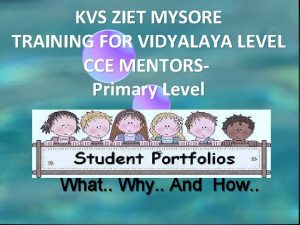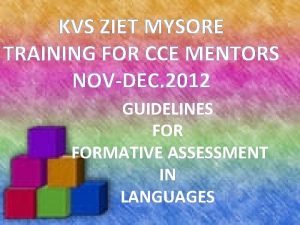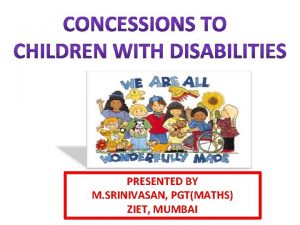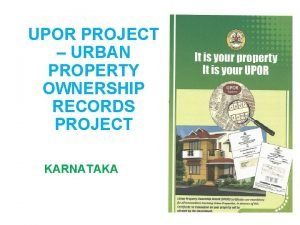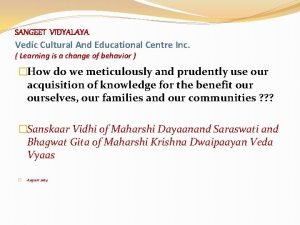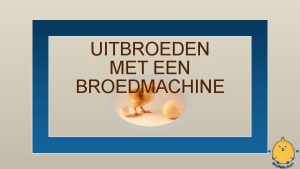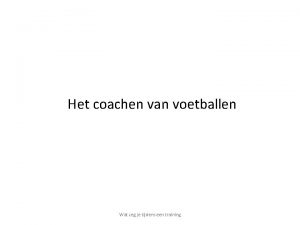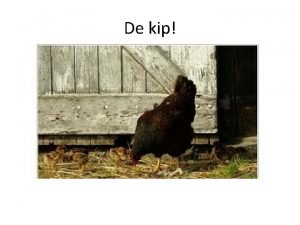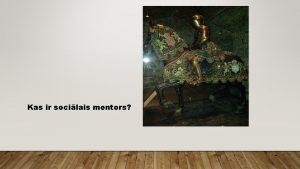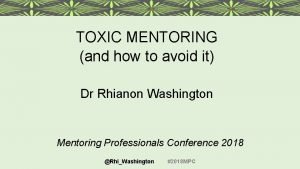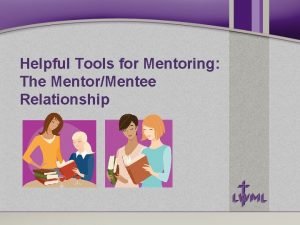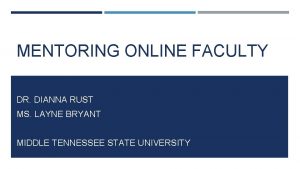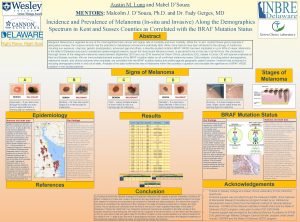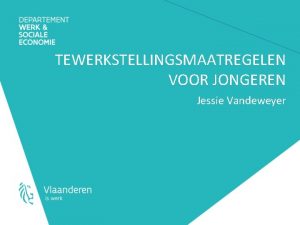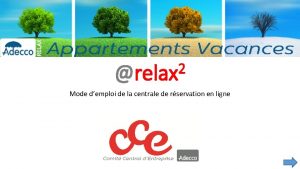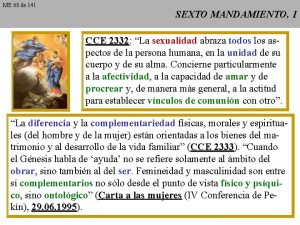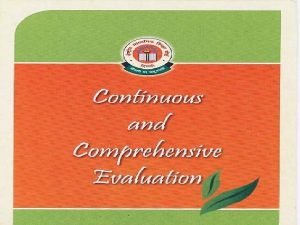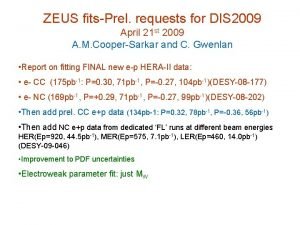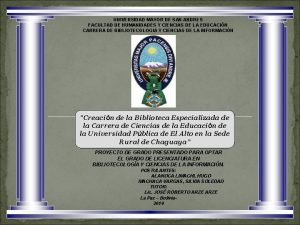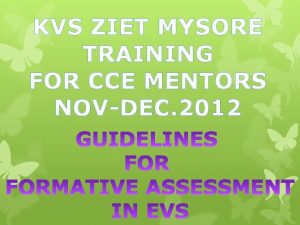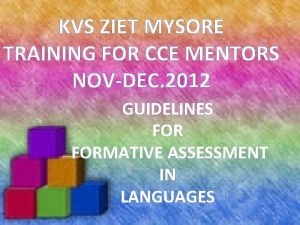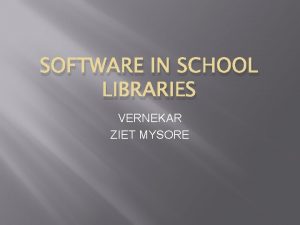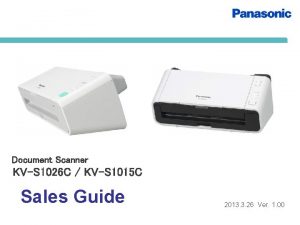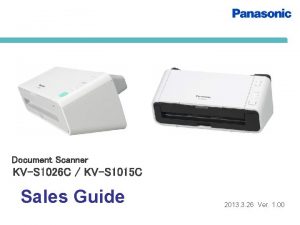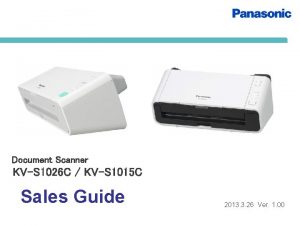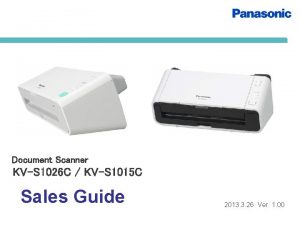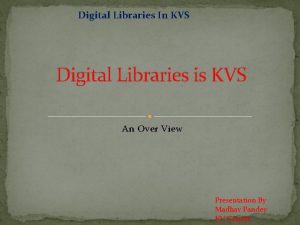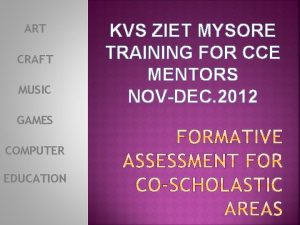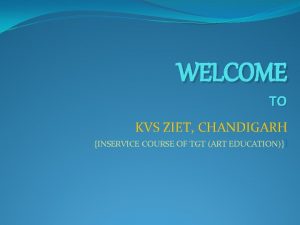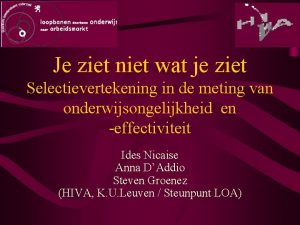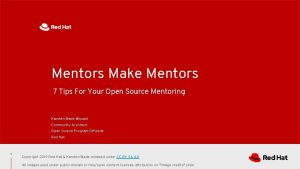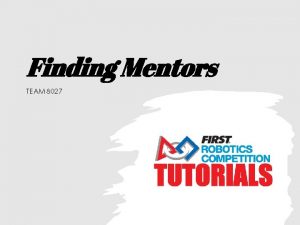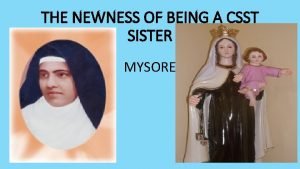KVS ZIET MYSORE TRAINING FOR CCE MENTORS NOVDEC





















- Slides: 21

KVS ZIET MYSORE TRAINING FOR CCE MENTORS NOV-DEC. 2012

SNAPSHOT OF THE PRESENTATION 1. 2. 3. 4. 5. 6. 7. 8. GENERAL INFORMATION LEARNING AND ASSESSMENT IN EVS COMPETENCIES -EVS KVS GUIDELINES INDICATORS OF ASSESSMENT BLUEPRINT OF ASSESSMENT CCE PLAN OF ACTIVITIES FORMAT FOR ASSESSMENT IN CLASSROOM- TEACHER RECORD 8. FORMAT FOR COMPUTATION- CCE SOFTWARE AT A GLANCE

an integrated perspective for the primary stage of schooling and draws upon insights from sciences, social studies and environmental education. The new EVS syllabus indicates the following objectives of teaching science and social studies at the primary stage: - to train children to locate and comprehend relationships between the natural, social and cultural environment - to develop an understanding based on observation and illustration, drawn from lived experiences and physical, biological, social and cultural aspects of life, rather than abstractions - to create cognitive capacity and resourcefulness to make the child curious about social phenomena, starting with the family and moving on to wider spaces - to nurture the curiosity and creativity of the child particularly in relation to the natural environment (including artifacts and people) - to develop an awareness about environmental issues - to engage the child in exploratory and hands-on activities to acquire basic cognitive and psychomotor skills through observation, classification, inference, etc. - to emphasise design and fabrication, estimation and measurement as a prelude to the development of technological and quantitative skills at later stages - to be able to critically address gender concerns and issues of marginalisation and oppression with values of equality and justice, and respect for human dignity and rights Source – Syllabus for classes at Elementary Level, based on NCF 200

example an Analysis and Inference: What kinds of cooked food did you eat? Non-Evaluatory Activity: Begin with children singing a song on food items. Evaluation Activity: List all the kinds of foods you have eaten in the last week. Use the tablegiven below for analysis. Now describe which kind of food items you ate the most. Grading Indicators A - Student identifies the issue herself and comes to a conclusion B - The issue is analysed but the inference is not correct C - The teacher needs to give clues for analysis and inference

COMPETENCIES IN EVS Observation and Reporting Identification and Classification Discovery of Facts

KVS GUIDELINES 1. ENVIRONMENTAL ACTIVITIES Reading with a Purpose(Making Notes), Oral Quizzes, Role Play, Presentation on Current Topics(Formulating one`s own reasoning for an observed event/activity), Group Discussion, Survey, MCQs, Charts, Models, Map Reading, Trips and Reports, Group Investigations, Source-based Analysis, Assignments (Class work and Homework) etc.

KVS GUIDELINES EVS April-May Written Assignments – Short/Long question answers (Classwork & Homework), Reading with a purpose (making notes), Role Play and Dramatization, Oral Quizzes etc. July-August Written Assignments – Short/Long question answers (Classwork & Homework), Presentations on current topics, Group Projects (Investigatory/Experimental), Survey, MCQs etc. November-December Written Assignments – Short/Long question answers (Classwork & Homework), Charts, Models, Map Reading, Group Discussion, Class response etc. January-February Written Assignments – Short/Long question answers (Classwork & Homework), Source- based analysis, MCQ, Field Trips and Reports, Group Projects (Investigatory/ Experimental) etc.

NO. OF COMPULSORY ACTIVITIES OPTIONAL ACTIVITY TIMELINE AREA 1 AREA 2 AREA 3 AREA 4 APR-MAY ONE ONE 4 JUL-AUG ONE ONE 4 TOTAL CONSOLIDATION OF FA 2 ASSESSMENT USING CCE SOFTWARE TO A WEIGHTAGE OF 10 TIMELINE AREA 1 AREA 2 AREA 3 AREA 4 TOTAL NOV-DEC ONE ONE 4 JAN-FEB ONE ONE 4 CONSOLIDATION OF FA 4 ASSESSMENT USING CCE SOFTWARE TO A WEIGHTAGE OF 10

CORE GUIDELINE NOTE: Three activities i. e. Written assignments, Group Projects and MCQ will be common under the scheme of FA 2 and FA 4. In addition, a teacher is free to carry out minimum one meaningful activity out of the suggested list of areas. Finally, the marks secured by children out of four or more activities under FA 2 and FA 4 need to be reduced to 10 respectively.

Syllabus Themes in the New Primary Syllabus The new syllabus is woven around six broad themes given belowthe predominant theme on ‘Family and Friends’ is made of four sub-themes: 1 Family and Friends – 1. 1 Relationships; 1. 2 Work and Play; 1. 3 Animals; 1. 4 Plants 2 Food 3 Shelter 4 Water 5 Travel 6 Things We Make and Do

INDICATORS IN OF LEARNING EVS

BLUEPRINT DESCRIBES THE ENTIRE PROCESS OF ASSESSMENT CLICK TO OPEN THE FILE REPORTING RECORDING EVIDENCE SUGGESTED INDICATORS FOR ASSESSMENT PERIODICITY METHOD OF CONDUCTING (inform the areas/ indicators of assessment to the children before the activity is conducted) DESCRIPTION ACTIVITY BLUEPRINT OF ASSESSMENT- A

CCE – SAMPLE PLAN OF ACTIVITIES

FORMAT FOR ASSESSMENT IN CLASSROOM- TEACHER RECORD FORMAT printed in the ZIET’s CCE Manual MODIFIED AND ILLUSTRATED FORMAT Print version format

FORMAT FOR COMPUTATIONCCE Software has the required features for automatic computation of grades , abstracts and analysis CCE SOFTWARE to be uploaded on ZIET library blog after the last schedule of Training for CCE mentors

SUGGESTIONS FOR IMPLEMENTATION 1. INTEGRATE ASSESSMENT ACTIVITIES WITH THE REGULAR TEACHING LEARNING 2. WORK WITH GROUPS OF STUDENTS RATHER THAN WHOLE CLASS 3. DIFFERENTIATE THE CONTENT, TLP (TEACHINGLEARNING PROCESS ) AND ASSESSMENT ACCORDING TO THE LEVELS OF THE LEARNER 4. PLAN ASSESSMENT ACTIVITIES FOR BLOCK PERRIODS 5. PLAN PORTFOLIO WORK FOR DESIGNATED DAYS / ‘NO BAG DAY’

DISCUSSION OF A TEACHER’S TIMETABLE IN TERMS OF THE FORMATIVE ASSESSMENT CYCLE

SUMMARY 1. The formative assessments are part of the Teaching-learning Process 2. They should be on a continuous mode regular and frequent. 3. A good Teacher Record of Assessment reflects Ø Regularity of Assessment Ø Criteria of Assessment Ø Diagnosis and remediation for the students with learning difficulties, progress for the average and enrichment for the advanced learner Ø Feedback to the Teacher and the Learner Ø Teacher’s reflections/ notes on the learning of the children on a regular basis

SUMMARY contd The BLUPRINT gives complete information on the Process of Assessment The CCE Plan gives a list of activities. However the teacher is free to conduct their own activities , keeping the competencies of EVS in mind as stated in the example. The Teacher Format serves as a complete record of the details of assessment , diagnosis, feedback, remediation and enrichment measures. The Teacher Record is comprehensive and if supported by sufficient evidence of student works in class work and portfolios , does not require additional records for remedial work etc. The scores from the teacher record are to be entered in the recommended software for computation, grading, analysis and abstract generated automatically by it.

SUMMARY contd 4. All computation of grades, analysis and abstract can be done using the recommended software 5. Evidence of Assessment is maintained by. Index entries in Classwork , Worksheet Folders and Portfolios Samples of products/artifacts of student works in student Portfolios Notes on performances such as role play, narrations, multimedia, etc in Portfolios

NCF 2005 School Based Continuous and Comprehensive Evaluation system is Introduced to: ü Reduce stress on children ü Make evaluation comprehensive and regular ü Provide space for the teacher for creative teaching ü Provide a tool of diagnosis and remedial action ü Produce learners with greater skills ( Position Paper on Aims of Education - NCF 2005, NCERT)
 Ziet mysore
Ziet mysore Kvs ziet
Kvs ziet Ziet mumbai
Ziet mumbai Upor mysore
Upor mysore Yoga sattwa mysore
Yoga sattwa mysore Bevruchting ei kip
Bevruchting ei kip Dagdraaiboek voorbeeld
Dagdraaiboek voorbeeld Wat voor soorten panda's zijn er
Wat voor soorten panda's zijn er Zeg wat je ziet
Zeg wat je ziet Hoe ziet een kip eruit
Hoe ziet een kip eruit Sociālais mentors
Sociālais mentors Toxic mentoring
Toxic mentoring Prayer for a mentor
Prayer for a mentor Examples of mentor archetype
Examples of mentor archetype Rust mentors
Rust mentors Mabel d'souza
Mabel d'souza Dgv mentor
Dgv mentor Ce adecco relax
Ce adecco relax Cce 2332
Cce 2332 What is cce
What is cce Cce+
Cce+ Cce upea ciencias de la educacion
Cce upea ciencias de la educacion
